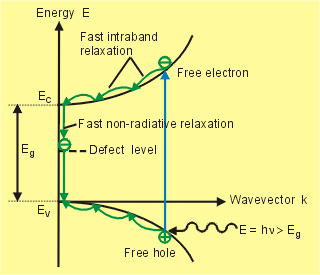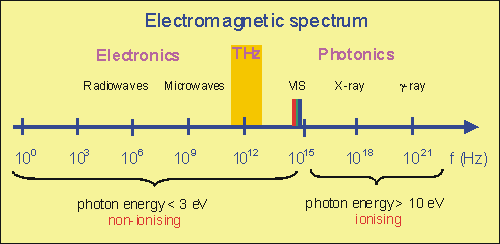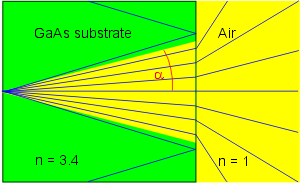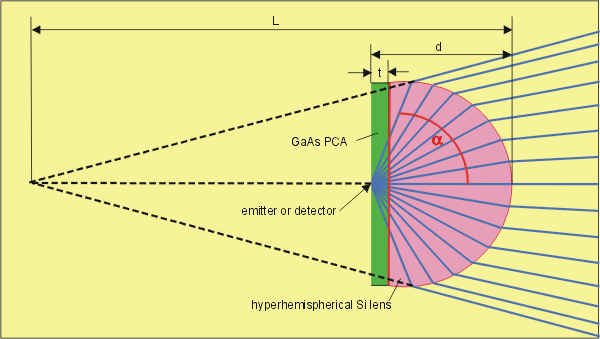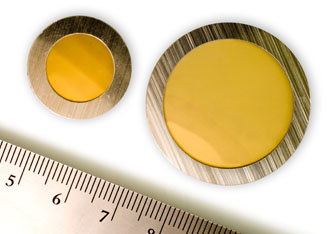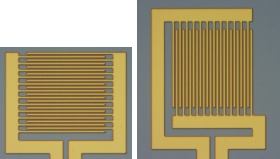Del Mar Photonics - PCA brochure - buy online - PCA Q&A
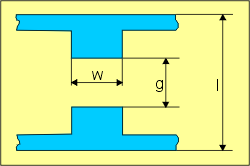
Geometrical antenna parameters:
- l - length of the antenna, defines the THz resonance frequency.
- g - gap distance, important for laser excitation.
- w - gap width.
| Part No. | Delivery time | l (mm) |
g (mm) |
w (mm) |
Description |
| PCA-44-06-10-800-x | 1 week | 44 | 06 | 10 | PCA: resonance frequency 1 THz,
l = 800 nm, gap distance 6
mm, optimal detector antenna |
| PCA-44-16-16-800-x | 1 week | 44 | 16 | 16 | PCA: resonance frequency 1 THz, l = 800 nm, gap distance 16 mm |
| PCA-44-34-100-800-x | 1 week | 44 | 34 | 100 | PCA: resonance frequency 1 THz, l = 800 nm, gap distance 34 mm |
| PCA-30-10-10-800-x | 1 week | 30 | 10 | 10 | PCA: resonance frequency 1.5 THz, l = 800 nm, gap distance 10 mm |
| PCA-30-14-14-800-x | 1 week | 30 | 14 | 14 | PCA: resonance frequency 1.5 THz, l = 800 nm, gap distance 14 mm |
| Part No. | Delivery time | l (mm) |
g (mm) |
w (mm) |
Description |
| PCA-44-06-10-1030-x | 1 week | 44 | 06 | 10 | PCA: resonance frequency 1 THz,
l = 990 .. 1060 nm, gap distance 6
mm, optimal detector antenna |
| PCA-44-16-16-1030-x | 1 week | 44 | 16 | 16 | PCA: resonance frequency 1 THz, l = 990 .. 1060 nm, gap distance 16 mm |
| PCA-44-34-100-1030-x | 1 week | 44 | 34 | 100 | PCA: resonance frequency 1 THz, l = 990 .. 1060 nm, gap distance 34 mm |
| PCA-30-10-10-1030-x | 1 week | 30 | 10 | 10 | PCA: resonance frequency 1.5 THz, l = 990 .. 1060 nm, gap distance 10 mm |
| PCA-30-14-14-1030-x | 1 week | 30 | 14 | 14 | PCA: resonance frequency 1.5 THz, l = 990 .. 1060 nm, gap distance 14 mm |
| Part No. | Delivery time | l (mm) |
g (mm) |
w (mm) |
Description |
| PCA-44-06-10-1040-x | 1 week | 44 | 06 | 10 | PCA: resonance frequency 1 THz,
l ~ 1040 nm, gap distance 6
mm, optimal detector antenna |
| PCA-44-16-16-1040-x | 1 week | 44 | 16 | 16 | PCA: resonance frequency 1 THz, l ~ 1040 nm, gap distance 16 mm |
| PCA-44-34-100-1040-x | 1 week | 44 | 34 | 100 | PCA: resonance frequency 1 THz, l ~ 1040 nm, gap distance 34 mm |
| PCA-30-10-10-1040-x | 1 week | 30 | 10 | 10 | PCA: resonance frequency 1.5 THz, l ~ 1040 nm, gap distance 10 mm |
| PCA-30-14-14-1040-x | 1 week | 30 | 14 | 14 | PCA: resonance frequency 1.5 THz, l ~ 1040 nm, gap distance 14 mm |
| Part No. example | Description |
| PCA-44-06-10-800-x | PhotoConductive Antenna |
| PCA-44-06-10-800-x | length l = 44 mm |
| PCA-44-06-10-800-x | gap distance g = 6 mm |
| PCA-44-06-10-800-x | gap width w = 10 mm |
| PCA-44-10-800-x | laser excitation wavelength l = 800 nm |
| PCA-44-06-10-800-0 |
unmounted chip, area: 2 mm x 2 mm, thickness: 400 Ám, with 4 bond contact pads |
| PCA-44-06-10-800-h | mounted on a
hyperhemispherical Si lens, 25.4 mm
diameter Al heat sink, 1 m long coaxial cable with BNC or SMA connector |

